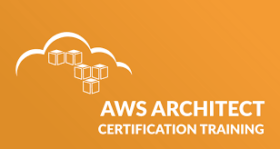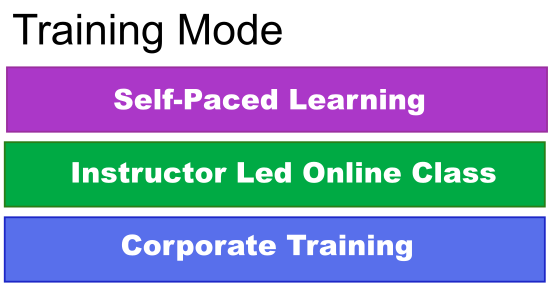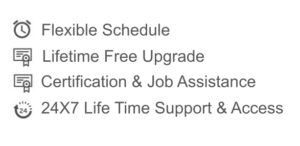Add to Wishlist
AWS Certified Solutions Architect Associate [SAA-C02]

History of Amazon
1
Why Cloud Computing is Good for Organizations as well as an Individuals
2
Advantages of Cloud Computing
3
Well-Architected Framework Discussion
4
Amazon Global Infrastructure :::Amazon Regions and AZs
5
EC2 Instances Launch Types
Amazon S3
1
Amazon S3 Buckets and Objects
2
Consistency Model in Amazon S3
3
Amazon S3 Use cases
4
Amazon S3 Access Control
5
Amazon S3 Security & Bucket Policies
6
Amazon S3 Versioning
7
How to Move Data To Amazon S3?
8
Can I Speed Up My Upload :: Multipart Upload
9
Amazon S3 Encryption
10
Amazon Transfer Accelerator
11
Amazon Snowball
12
Amazon Snowball edge
13
Amazon Snowball mobile
14
Amazon S3 Use cases:: When to Use and When Not To Use
15
Amazon S3 Cost
16
Amazon S3 Glacier
17
Amazon S3 Glacier Archive and Valuts
18
Cost to Move data to Amazon Glacier
19
Amazon S3 storage classes Discussion
20
How to Choose a Region ?
ADDING A COMPUTE LAYER
1
What is a Compute Layer ?
2
Amazon Machine Image (AMI) and Ec2 Discussion
3
How AMI Help the Organizations ?
4
How to Build AMI Image
5
EC2 AMI Hands On
6
Cross Account AMI Copy
7
Launching an Amazon Ec2 Instance with user Data
8
Meta Information Discussion
9
Amazon EC2 and Storing Data on It
10
Amazon EBS Introduction
11
Amazon EBS Volume Types
12
EBS Operation: Snapshots
13
EBS Operation: Volume Encryption
14
EBS vs Instance Store
15
Shared File System ::: EBS / S3 / FSX
16
Amazon Elastic File System
17
Amazon FSx
18
AMAZON EC2 and Instance TYPES
19
Discussion About Naming Convention
20
AMAZON EC2 Instance Types
21
AMAZON EC2 and Instance Sizes
22
Instances generation and cost
23
AMAZON EC2 and It’s Pricing Option
24
OnDemand Instances
25
Reserved Instances
26
Dedicated Hosts
COST SAVING PLAN
1
Spot Instances & Spot Fleet
Amazon EC2 Tenancy
1
Amazon Compute Optimizer
2
How to Keeping Track of Your Instances
3
Use of Tagging
4
Amazon EC2 Considerations
5
Architectural Considerations
6
Amazon EC2 Placement Groups
Adding A Database Layer
1
Database Layer Considerations
2
Database Types:: Relational & Non-Relational
3
Compare and Contrast Structured Data Storage
4
Managed Vs Unmanaged Databases
Amazon RDS and Amazon DynamoDB
1
Amazon RDS Overview
2
Amazon RDS and Amazon Aurora
3
Amazon RDS Use Cases
4
Amazon DynamoDB
5
Data Distribution: Partition Key and Sort Key
6
Amazon DynamoDB Has Global Tables
7
Use Cases of Amazon DynamoDB
8
Consistency Options for Amazon DynamoDB
9
Security Controls for Amazon RDS and DynamoDB
10
How to Migrating Data into Your AWS Databases:: AWS DMS
11
Migration Options:: OneTime vs Ongoing
12
Using AWS Snowball Edge with AWS DMS
13
How Schema can be Converted using AWS Schema Conversion Tool
Networking In AWS -part-1
1
Amazon Virtual Private Cloud (VPC)
2
Default VPC Overview
3
Amazon VPC Specifics
4
Deploying A VPC
5
Multi-VPC Pattern & Multi-Account Pattern
6
VPC and IP Addressing
7
CIDR, Private vs Public IP
8
Subnet Overview
9
Subnets: Key Attributes
10
Route Tables: Directing Traffic Between VPC Resources
11
Network Isolation by Subnets
12
Internet Gateways & Route Tables
13
NAT Instances
14
NAT Gateways
15
Subnet Use Case Examples
16
Basic Subnet Configuration
17
Elastic Network Interfaces
18
Private vs Public Address
19
Elastic IP Addresses
20
Security in the Cloud
21
Security Groups
22
chaining of Security Groups
23
Network Access Control Lists (ACLs)
24
Multiple Layers of Defense for Your Infrastructure on Amazon Cloud
25
Directing Traffic To Your VPC
Networking In AWS Part 2
1
High Availability on Networking Part
2
How to Connect Networks in Amazon AWS
3
Introduction of Virtual Private Gateway (VGW)
4
Extending On-Premises Network to AWS: VPN Connections
5
Extending On-Premises Network to AWS: Multiple VPN
6
AWS Direct Connect (DX)
7
DX Use Cases
8
Extending On-Premises Network to AWS: Using DX
9
AWS Direct Connect Resiliency for Critical Workloads
10
How to Connect 2 or More VPCs
11
VPC Peering
12
Peering Multiple VPCs
13
Connecting VPCs – Transit Gateway
14
VPC Endpoints & its Types
15
Accessing VPC Endpoints from Outside the VPC
16
What is AWS PrivateLink
17
Load Balancing on AWS
18
Elastic Load Balancing (ELB)
19
Why You Should Use ELB ?
20
Cloud Design Pattern: Application Load Balancer
21
Classic Load Balancer (CLB) with
22
Application Load Balancer (ALB) with Hands On
23
Network Load Balancer (NLB) with Hands On
24
Elastic Load Balancer – Stickiness
25
Elastic Load Balancer – Cross Zone Load Balancing
High Availability
1
Examples of High Availability
2
Multi-Region High Availability and DNS
3
Amazon Route 53
4
How Does Route 53 Help with High Availability?
5
Route 53 Routing Options
6
Routing Policy – Simple round robin
7
Routing Policy – Weighted round robin
8
Routing Policy – Latency-based routing
9
Route 53 Health Checks
10
Routing Policy – Failover
11
Routing Policy – Geolocation routing & Geoproximity routing with traffic biasing
12
Routing Policy – Multi Value answers
AWS Identity and Access Management (IAM)
1
What is User Account and IAM ?
2
AWS Identity and Access Management
3
Discussion on IAM Principals
4
Understanding IAM Users
5
IAM Permissions
6
Identity-Based Policy vs Resource-Based Policies
7
IAM Policy Example
8
Organizing My Users
9
Discussion on IAM User Group
10
Discussion on Federating Users:: Assume a Role
11
Security Token Service (STS)
12
SAML Discussion
13
Identity Federation & Cognito Discussion
14
Directory Services – Overview
15
AWS Landing Zone
16
Multiple Accounts
17
AWS Recommendations for Managing Multiple Accounts
18
AWS Organizations
Elasticity
High Availability
and Monitoring
1
Factors Affecting High Availability
2
Discussion on Elasticity & Types of Elasticity
3
Monitoring
4
Why Monitoring is a Need
5
Monitoring Infrastructure with Amazon CloudWatch
6
Discussion on The Ways CloudWatch Responds
7
Monitoring Your Users with AWS CloudTrail
8
Monitoring Your Network with VPC Flow Logs
9
Scaling Your Architecture to Gain Elasticity
10
Discussions on Various Ways to Auto Scale
11
Scaling our Databases
12
Horizontal Scaling with Read Replicas: Amazon RDS
13
Aurora DB Cluster
14
Aurora Serverless
15
Scaling Amazon RDS Writes with Database Sharding
16
Scaling DynamoDB
17
DynamoDB Adaptive Capacity
Automation
1
What is Automation and Why it is Needed?
2
How to Automate Your Infrastructure
3
How Automation Does Work?
4
Infrastructure as Code (IaC) and its Benefits.
5
AWS OpsWorks for Infrastructure and Deployment Automation
6
Lifecycle Events for OpsWorks Stacks
7
Using AWS OpsWorks Stacks with AWS CloudFormation
8
AWS Elastic Beanstalk
Caching
1
What Should I Cache?
2
Types of Caching For Your Architecture
3
Caching On AWS
4
Content Delivery Network (CDN)
5
Amazon CloudFront
6
How Caching Works in Amazon CloudFront
7
How to Configure CloudFront
8
Discussion on Caching Your Web Tier
9
Session Management
10
When Using DynamoDB for State Information
11
Caching Your Database
12
When Should You Start Caching Your Database?
13
When Using DynamoDB for State Information
14
Amazon DynamoDB Accelerator
15
When Using DynamoDB for State Information
16
Amazon ElastiCache
17
How Does It Work?
18
Redis and Memcached
19
AWS Cloud Architecture: Web Hosting
Building Decoupled Architectures
1
Tightly Coupled vs Loosely Coupled Systems
2
Why Decoupling is Required ?
3
Decoupling with Amazon SQS
4
Amazon Simple Queue Service (Amazon SQS)
5
Queue Types
6
Amazon SQS – Standard Queue Hands & Amazon SQS – FIFO Queues
7
SQS General Use Cases
8
Amazon SQS Features
9
Amazon SQS – Message Visibility Timeout
10
Amazon SQS – Dead Letter Queues
11
Amazon SQS – Delay Queues
12
Amazon SQS Message Lifecycle
13
Messaging Use Cases
14
Decoupling with Amazon SNS
15
Amazon Simple Notification Service (Amazon SNS)
16
Amazon SNS Subscription Types
17
General Use Cases for Amazon SNS & its Characteristics
18
Achieving Loose Coupling with Amazon SNS and Amazon S3
19
How is Amazon SNS Different from Amazon SQS?
20
• Developing with Amazon MQ
21
High Availability and Durability in Message Queue
22
When To Use MQ vs SQS or SNS
Microservices and Serverless Architectures
1
What Are Microservices?
2
Characteristics of a Microservice
3
Containers
4
Containers vs. Virtual Machines
5
Containers on Amazon EC2
6
Amazon Elastic Container Service (Amazon ECS)
7
Monolithic Application to Container-Based Microservices
8
Monolithic to Container-Based Microservices
9
AWS Fargate
10
What Is Serverless Computing?
11
AWS Lambda
12
Benefits of Serverless Computing
13
Example: Amazon S3 and AWS Lambda for Order Processing
14
Amazon API Gateway
15
General Serverless Architecture Using API Gateway
16
AWS Step Functions
RTO/RPO and Backup Recovery Setup
1
Disaster Planning–What to PLan ?
2
RPO and RTO
3
Essential AWS Services and Features for Disaster Recovery
4
Storage Duplication for Recovery
5
AWS Backup
6
Networking Disaster Recovery Options
7
Databases Should Be Backed Up and Redundant
8
Use of Automation To Quickly Recover
9
Examples of Backup and Restore
10
Backing up On-Premises Data to AWS
11
AWS Storage Gateway
12
Use Case: Off-Site Backup Solution with Gateway-Stored Volumes
13
Restore Backup To On-Premises Data Center: Gateway-Stored
14
Backup and Restore
15
Pilot Light Example
16
Fully Working Low-Capacity Standby
17
Multi-Site Active-Active
18
Common Practices for Disaster Recovery on AWS
Optimizations and Review
1
Re-Architecting
2
How Do You Make an Architecture Loosely Coupled?
3
Introduce an Amazon SQS Queue
4
How Can You Make This Architecture More Resilient?
5
What Type of Instance?
6
10 Best Practices for Building Systems with AWS






